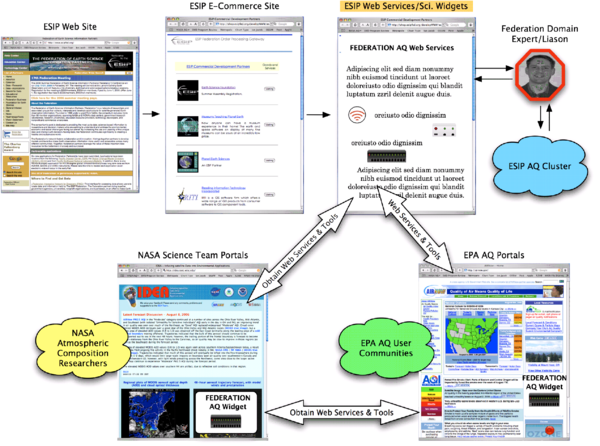AQ Collaborative Framework by Frank Lindsay
Framework for an Air Quality Collaborative Consortium
Premise: It is recognized that there are currently multiple organizations interested in the topic of Air Quality (AQ). These diverse interests take on many forms including environmental monitoring, science investigations, applications and decision-support, to name a few. The key players in AQ monitoring and investigation come primarily from multiple US federal agencies, academic/research institutions, non-profits, and other groups and associations. The issue at hand is how to leverage these diverse activities so that all AQ parties may significantly benefit from the numerous resources and efforts currently being expended. In other words is there a way for this diverse group to better orient these current efforts to the benefit of other organizations and, where appropriate, develop strategic partnerships to gain “economies of effort” for AQ work? A loose framework, suggested here, may enable all the interested parties to leverage pertinent AQ work and possibly further maximize resources currently spent on our AQ efforts and needs. This framework suggests that governance of individual AQ resources/capabilities remain in those domains while “shared” or “community” resources could be made more available.
The ESIP Federation: The ESIP Federation (Federation) is a non-governmental, multi-institutional entity that provides an organizational structure to the broad topic of Earth system science and related applications, education/outreach, and for-profit activities. The Federation has numerous means for the internal organization of expertise and resources that can be brought to bear on critical science-related issues and opportunities. A sub-group (or cluster) within the Federation focuses on the topic of Air Quality. This Federation cluster brings together a range of domain experts that largely focus on the issues of data access and the development of higher-order goods and services relating to air quality information. Currently, the Federation maintains the mechanisms needed to promote its AQ-related capabilities, expertise and resultant data and services. The Federation web site (www.esipfed.org) is the group’s ‘front door’ providing access to general information and other services. In addition, the Federation has developed an E-commerce enabled we site that is ‘policy neutral’ where Federation goods and services can be openly distributed or purchased by interested parties (shop.esipfed.org/). Augmenting current Federation capabilities is the basis for the framework partnership discussed here.
The Framework: This proposed AQ framework centers on a ‘light touch’ approach where parties can independently determine the degree of engagement with other AQ activities or partnering relationships. The schema for this framework plan is shown in Figure 1. This figure illustrates some of the existing AQ elements shared across our AQ partnership group. The enabling technology for a proposed AQ collaboration rests with the emergence of internet-based web service architectures (e.g. JSR 168, SOAP, etc.). The advent of these web services will allow the parties to share capabilities developed for AQ monitoring and research.
The role of the ESIP Federation under this framework would be a non-governmental source for AQ information and services. This role could be implemented by the development of a new, or a retooled, web site where the collection of tools, services, data, and information pertinent to AQ can be published (see Figure 1). This site would be mediated by the AQ Cluster whose domain experts would have the oversight of materials/information published to this web site. This AQ site (or portal) could be one of many developed by the Federation and would perhaps form the basis for the larger EIE portal effort.
The Federal agencies involved in AQ research and monitoring (EPA, NASA, NOAA, USDA, etc.) could all leverage the work of the Federation AQ Cluster via the proposed Federation AQ web portal or other collaborations established by Federal agencies representatives. Some possible scenarios of this collaboration may be:
- Federal agencies directly use web services or information streams developed by the Federation on their own monitoring or research web sites (e.g. AirNow places a Federation AQ tool on its EPA-hosted site).
- Federal agencies refer to the Federation AQ web site as the source for information, tools or services (e.g. leverage the Federation rather than establish a new, separate capability relating to some facet of AQ).
- The Federation and one or more of the Federal agencies could partner on the development of a needed capability , data stream, or information resource for the AQ community. This partnership could be established by a direct work plan negotiated with the Federation AQ Cluster.
- The Federation AQ Cluster could work directly with Agency personnel to exchange, share or acquire tools and services needed for AQ research or monitoring.
There are potentially many forms an AQ partnership framework could take. The goal of this collaboration should be to cross-leverage activities being conducted by the parties while maintaining needed autonomy and independence in the development of capabilities and the need to perform current AQ-related responsibilities. The zone of the collaboration is at the interfaces where, as shown in the arrows of Figure 1, the exchange of knowledge and resources can most easily and effectively occur. As mentioned this framework enables all the parties to decide to what degree, timing and the longevity of any AQ collaboration. The benefit for the Federal agencies will come from the nimble and cutting-edge advances the Federation AQ Cluster is able to develop through their broad collaborations with technology and science experts. These advances in technology and AQ data and information dissemination can be adopted by the Federal agencies as needed for their own research and monitoring efforts.
The advances in web technologies will make this loose but coupled partnership possible. This AQ collaboration is more than pointing to or cross referencing existing web pages. The integration and sharing of web-enabled AQ resources across the partners would form a next-generation network of capabilities where our users can take advantage of the logical connections (or chaining) of tools and services from multiple partners (both Federal and Non-governmental entities).
